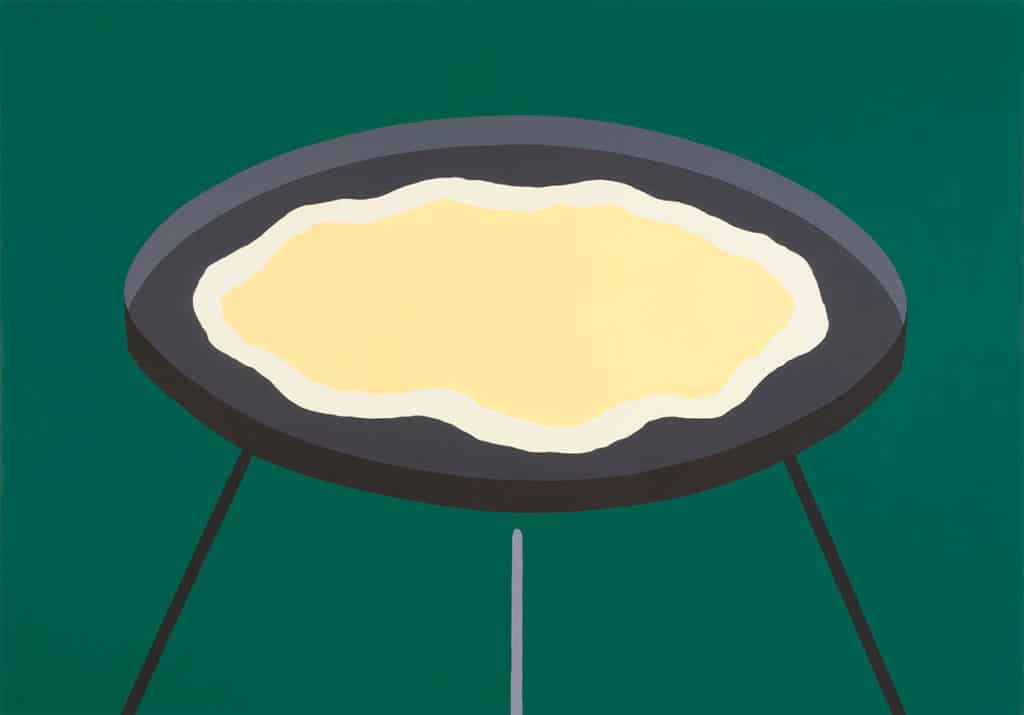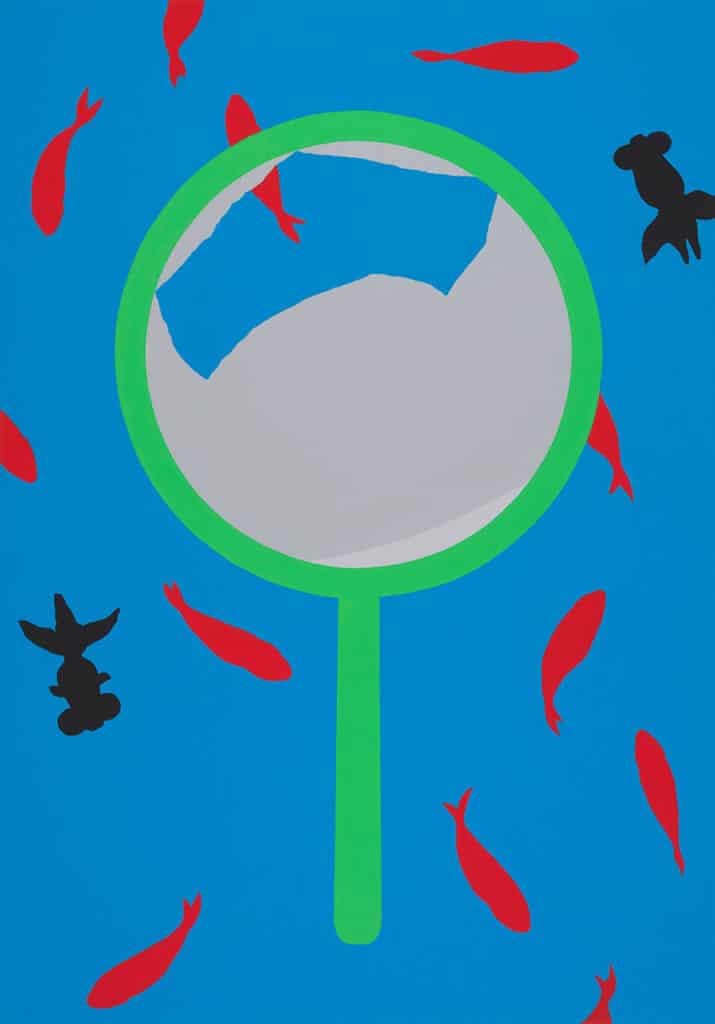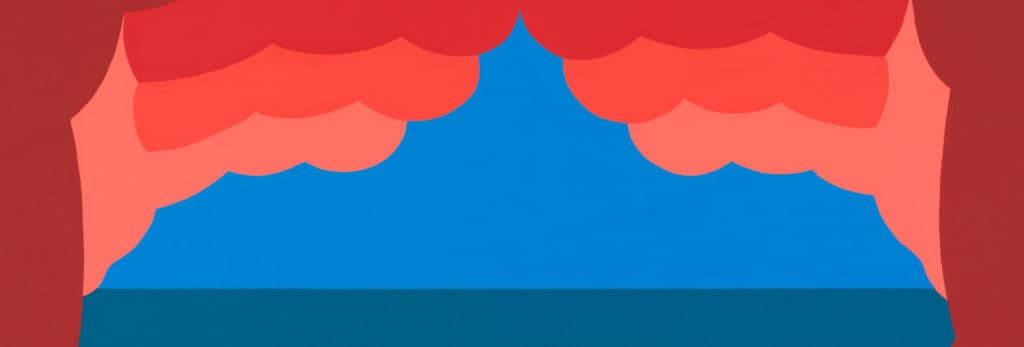We are talking to Yui Akiyama, a distinguished finalist of the Best Art Academy diploma work contest, an artist born in Osaka. Akiyama passed her master’s diploma examination this year at the Faculty of Painting at the Academy of Fine Arts in Warsaw under the supervision of professor Jarosław Modzelewski. The artist’s works were showcased during an exhibition organised in the Armoury of Arts in Gdansk. They have made a strong impressions on the editors of Contemporary Lynx, and that is why we have decided to publish an interview with Akiyama in our magazine.
Michalina Sablik: You came to Poland a few years ago to study Polish language and culture, and now you are publishing a book with your texts in Polish. You paint, you create installations and have received an honourable mention at a prestigious contest for the best diploma works prepared by students of Polish art academies. How does this make you feel?
Yui Akiyama: I am glad to have experienced these things and I am grateful for the kind of people I met here. But when you list only the points which would look good on your CV, I feel like I listen to another person’s story. Of course, various things have been happening in between, and they are equally important to me.
M.S.: Tell us about the road you’ve travelled. It seems highly interesting that studying in Kyoto you took interest in Polish culture, that you started learning the language on your own and decided to study in Warsaw.
Y.A.: It happened a bit differently. I got interested in Polish culture thanks to a book by Toshio Shimao, a Japanese novelist. I used to read his works as a student. Shimao had gone on a journey to Poland two times at the turn of 1960s and 1970s and wrote a book based on his experience. Back then, I was studying art and the history of aesthetics. But the idea of learning Polish did not come to my mind at this stage. I only started learning several years later, after I began working. I wanted to take up something new and I recalled Polish. I met a student from Poland and she became my first teacher. We had classes in a cafe. But that was just my hobby. I visited Poland the following year. I liked it here so much that I returned to Poland within the following two years. I decided to stay here during my fourth visit, and started working as a Japanese language teacher. My goal was to learn Polish. I was admitted to art school a while later.

Yui Akiyama and Mateusz Pawlak, exhibition view, WizyTUjąca Gallery, photo Piotr Grześczyk, courtesy of the gallery
M.S.: It is interesting that you are the oldest graduate whose works are presented in the Gdańsk Armoury. Most artists are young people in their twenties who for example, chose to be painters in high school. Your career looks a little different.
Y.A.: Art was always close to me and I’ve been drawing since as long as I remember. I wanted to take exams to art academy in Japan but I chose university for practical reasons. I returned to art in Poland. I took up a weekend painting course, not knowing that it was a preparatory course for exams to art academy. I treated it as a hobby for a year, but then I thought that I could actually take up studies.
M.S.: “No to do zo bo po co” is the title of your diploma work. What is its origin?
Y.A.: I heard this phrase on the bus. Someone was talking on the phone and said the words to end the conversation. I figured out that it meant: “we’ll meet to talk things over. Why are we talking about everything now on the phone? So see you.” I do not know if I understood this well, but I liked the form of the phrase. It is simple and efficient, but it carries a lot of meanings, stories, emotions and the relation between them. Besides, it is very Polish to me, at the same time consisting of seven syllables, just like haiku. I thought that the phrase is interesting and its nature describes my exhibition well. I also gave it a Japanese title “Yu me de a e ta ra” which could be literally translated into Polish as “See you in my dreams”.

Yui Akiyama,scramble eggs on grill, 2017, acryl, canvas, 140 x 200 cm, courtesy of the artist.
M.S.: You place elements of exotic culture in your works – gold fish, Buddha temples, manga which are combined with your day-to-day experience in Poland. How are your paintings and texts created?
Y.A.: I do not like it when people want only “Japanese elements” in my works, just as I do not like it when people start talking English to me, based only on my appearance. I was born and brought up in Japan. I lived there for 30 years. That is why I am immersed in “Japan” in a natural and rather inevitable way. I think that it is natural that “Japanese” things appear in my works, because they are usually the underlying part of my experience. For example, my painting entitled “Amulet Factory” originates from my work during studies when I was trying to earn some extra money in an amulet factory. Or “Gold Fish” also depicts my childhood memory of one of the summer festivals during which children catch gold fish (kingyo-sukui) with paper scoops.
M.S.: You were writing your book “Between Image and Text” for a few years in your own language which is a mixture of Polish and Japanese. How did you work on it?
Y.A.: I enjoy writing. I often write while drawing at the same time. But I do it in a chaotic way – the texts are rather “fragments.” They are not readable. I do it for myself only. I write most of the texts in Japanese, but Polish appears too. And the drawings – they are mixed just as in my head.
As for the book, I first did some sketches in Polish and then I worked on them with my friend, a native speaker. We corrected grammar, word order and chose more appropriate wording. But it was crucial to retain “my Polish” so I used only the words I knew, I did not want it to be “perfectly correct.” I wanted to feel that it was my work and that I was responsible for every word.

Yui Akiyama, Gold fish, 2017, acryl, canvas, 140 x 200 cm, courtesy of the artist.
M.S.: In the introduction to your book you write that the experience of two cultures is important to you. Analysing the language allows for discovering metaphors, meanings, notions natural in a given culture. How does writing in a foreign language help you distance yourself from that and discover a new way of thinking?
Y.A.: I constantly think of what I can share with a person who does not have the same context. I came to Poland 7 years ago. I became a “foreigner” then. As a foreigner I began to wonder how I could communicate in a language understandable to this other person and at the same time remain myself. Keeping my individuality, which is a kind of lack of understanding, how can I express myself so that the other person feels that the writing is close to her? Visual art operates differently than words, but I think that in a sense they have a lot in common.
M.S.: You write, you paint, you design, you make installations. Is any of the fields closer to you than others?
Y.A.: I always try to look for work methods in which I feel comfortable and which are in harmony with the topics. I try not to bother too much with the category of media. The form of book allowed me to combine my paintings and texts. But it’s not that I believe that a painting is better than a book etc. – they are totally different beings.
M.S.: At the exhibition in the Art Armoury in Gdansk you presented your installation entitled “I’ve drawn conclusions from my past by accident”, can you tell me a bit about the idea for this work?
Y.A.: I think that phrases “draw conclusions from the past” are usually used in a positive sense. But while painting a picture which became the basis for my installation, I thought that conclusions from the past can be traumatic, can cause cognitive distortion, bad thinking habits. The past and our experience can help us, but can also disturb us. And I chose this form to present this idea. It was important that this point of departure was not so crucial after I finished the work. History and completed work have a different character. The nature of the work was changing naturally during the creation process. Perhaps the initial feelings concerning the subject matter of the work were “negative”, but I think that the final outcome is humorous and cheerful. And I believe that my feelings, my way of thinking and outlook also underwent changes. Perhaps I can say that that the creation process helped me overcome, or rather understand and make peace with the things which had bothered me.

The Esteemed Graduates of Polish Academies of Fine Art 2017, exhibition view, photo: Bartosz Żurowski, courtesy of the Academy of Fine Arts in Gdańsk.
M.S.: Let’s talk about the form of your paintings. You use flat colourful patches in contrasting colours. Your works are a bit poster-like, you use aesthetic minimalism, your works are full of paradox and a subtle play on meaning.
Y.A.: This is the case of my diploma work. But I am willing to change that form in my next works. I am constantly searching for new ways.
When I was preparing my diploma work, I had this assumption that the more obvious something is to me, the less obvious it is to others. And I think ambiguity is more intriguing. But the things obvious to me are not easily noticeable to others. That is why I tried to get the images out of my head, just as they are, without any improvements. And the paintings are collections of various elements I saw somewhere – photos, films, television, someone’s paintings, comic books, packaging, posters, landscapes, snapshots of every-day life. And they are merged in my head in an oneiric way.
M.S.: Yet your works are not formalism. What was the most important idea you wanted to share in the presented works’ series.
Y.A.: I sometimes find “that something” in works of art or literature. “That something” is what I cannot express, or rather something I cannot notice until I find it in other artist’s works. I find it very interesting and I feel that it is a form of rescue to me in a way. It’s not that “that something” is the answer to a given problem. The fact that “that something” has been expressed is great.
I am clumsy in interpersonal relations, I experience various thoughts and emotions all the time. In my opinion, people usually treat them as something useless, negative, and even treat them as if they have never existed. I used to perceive them as something negative and I was ashamed to think about them. When I was a child, adults would tell me: “You have too much free time, why do you keep thinking about such things.”
But today, after all these years I can say that I know that I am a human being whose head is full of emotions, no matter if they have free time or not. And I decided that I want to value such thoughts and emotions.
I sometimes imagine that I would like to catch these various emotions and study them carefully, just like catching insects and placing them in display cases, carefully watching their somewhat scary but beautiful and diverse shapes or strange, magically shining colours of wings. If there is anything I want to deal with in art, these are emotions.
But talking about something and actually doing it with your own hands are two completely distant things. That is why when I am asked why I had chosen a given colour, form of topic, I cannot answer in another way than just “somehow”, “intutitively”. I thought it would fit.” It is not that I am certain of my choices right away. I test my ideas, I search all the time. Even when the work is finished, my mind is not made up. And then I deal with the issue in my next work.









